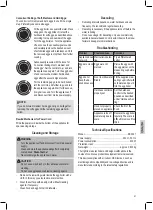
40
PORTUGUE
S
PORTUGUE
S
ČESKY
ČESKY
CAUTION:
The product must not be immersed into water for cleaning.
• Please follow the instructions as outlined in the chapter “Cleaning
and Storage”.
Initial Operation
• Remove all parts carefully from the packaging.
• Clean the appliance before first use as described under
“Cleaning and Storage ”.
Mains Cord
Unwind the mains cord from the base.
Electric Connection
• Ensure that your mains power corresponds to the appli-
ance’s specifications on the type label.
Operation
NOTE:
You can boil up to 7 eggs concurrently.
1. Place the appliance on a flat, level and dry surface. The
surface should be non-slip and heat resistant.
2. Fill the supplied measuring cup fully with cold water and
pour it into the egg boiler.
3. Insert the egg holder.
4. Pierce each egg at the bottom with the egg piercer at the
bottom of the measuring cup to avoid cracking. Carefully
press the egg on the piercer.
5. Place the eggs with the pierced side up evenly spaced in
the egg holder.
6. Close the hood.
7. Connect the power plug to a properly installed wall outlet.
8. Set the hardness control to the desired position as de-
scribed under “Hardness Setting”.
9. Turn the appliance on. The status indicator lights up.
10. The acoustic signal sounds as soon as the eggs reach the
desired hardness. Turn the appliance off and disconnect
from mains power supply.
11. Remove the hood only by taking hold of the handle.
WARNING: Risk of scalding!
When opening, tilt the hood in such way that the steam
escapes from the side opposite the handle.
12. Remove the egg holder from the egg boiler and chill under
cold water to avoid further cooking.
13. Let the appliance cool down completely before further use
or storage!
Hardness Setting
NOTE:
The hardness control sets the boiling time and therewith the
hardness of the eggs. The icons serve your orientation.
Icons for “boiling eggs with the same hardness”
Soft eggs
medium hard eggs
hard eggs
Icons for “concurrent boiling of soft, medium and hard
eggs”
medium hard eggs
hard eggs
Boiling Eggs with the Same Hardness:
Within the desired hardness the setting is determined by
number and weight class of the eggs (S, M, L, XL).
Examples:
1 small egg (weight class S) is to be soft
boiled:
- Set hardness control with the notch to
the onset of the boiling range for soft
eggs.
1 large egg (weight class XL) or 7 small
eggs are to be soft boiled:
- Set hardness control to the centre of
the boiling range.
7 large eggs are to be soft boiled:
- Set hardness control to the end of the
boiling range.
Try the different settings. Thanks to the electronic boiling control
you will be able to get excellent results after a short time.
Summary of Contents for EK 3321
Page 63: ......






























